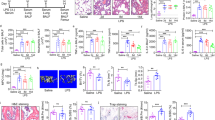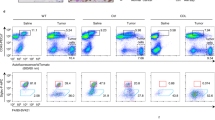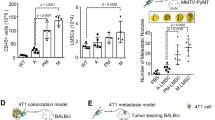Abstract
We have previously shown that tumor necrosis factor (TNF)α produced from primary tumor-induced expression of two endogenous Toll-like receptor 4 (TLR4) ligands, S100A8 and serum amyloid A3 (SAA3), in pre-metastatic lungs. However, mechanistic details of the signaling network and relevance to pulmonary physiology are poorly understood. Here, we identify Clara cells as a control tower of the network. Clara cell ablation by naphthalene suppressed pulmonary recruitment of CD11b+TLR4+ cells and spontaneous lung metastasis. Clara cells turned out to express TLR4 through which SAA3 was auto-amplified. Reciprocal bone marrow transplantation between wild-type and TLR4 knockout mice demonstrated that pulmonary TLR4+ Clara cells could be derived from bone marrow. SAA3-induced TNFα expression in both alveolar type II cells and macrophages. Primary co-cultures of alveolar type II cells and Clara cells revealed that the induction of TNFα in alveolar type II cells was dependent on the Clara cell-mediated amplification of SAA3. SAA3 induction by bacterial endotoxin also required both Clara cells and TLR4. Thus, pulmonary metastatic soil may feature deregulation of homeostatic inflammatory responses to constant assaults of microbes with endotoxin.
This is a preview of subscription content, access via your institution
Access options
Subscribe to this journal
Receive 50 print issues and online access
$259.00 per year
only $5.18 per issue
Buy this article
- Purchase on Springer Link
- Instant access to full article PDF
Prices may be subject to local taxes which are calculated during checkout






Similar content being viewed by others

References
Armstrong L, Medford AR, Uppington KM, Robertson J, Witherden IR, Tetley TD et al. (2004). Expression of functional Toll-like receptor-2 and -4 on alveolar epithelial cells. Am J Respir Cell Mol Biol 31: 241–245.
Arsalane K, Broeckaert F, Knoops B, Wiedig M, Toubeau G, Bernard A . (2000). Clara cell specific protein (CC16) expression after acute lung inflammation induced by intratracheal lipopolysaccharide administration. Am J Respir Crit Care Med 161: 1624–1630.
Atkinson JJ, Adair-Kirk TL, Kelley DG, deMello D, Senior RM . (2008). Clara cell adhesion and migration to extracellular matrix. Respir Res 9: 1.
Balkwill F . (2009). Tumour necrosis factor and cancer. Nat Rev Cancer 9: 361–371.
Bing Z, Huang JH, Liao WSL . (2000). NF-κB interacts with serum amyloid A3 enhancer factor to synergistically activate mouse serum amyloid A3 gene transcription. J Biol Chem 275: 31616–31623.
DeNardo DG, Barreto JB, Andreu P, Vasquez L, Tawfik D, Kolhatkar N et al. (2009). CD4(+) T cells regulate pulmonary metastasis of mammary carcinomas by enhancing protumor properties of macrophages. Cancer Cell 16: 91–102.
Devoogdt N, Hassanzadeh Ghassabeh G, Zhang J, Brys L, De Baetselier P, Revets H . (2003). Secretory leukocyte protease inhibitor promotes the tumorigenic and metastatic potential of cancer cells. Proc Natl Acad Sci USA 100: 5778–5782.
Dobbs LG, Gonzalez R, Williams MC . (1978). An improved method for isolating type II cells in high yield and purity. Am Rev Respir Dis 134: 141–145.
Franklin GA, Scott MJ, Patel M, Hoth JJ, Peyton JC, Cheadle WG . (2003). A novel model of pneumonia from intraperitoneal injection of bacteria. Am J Surg 186: 493–499.
Gardella S, Andrei C, Ferrera D, Lotti LV, Torrisi MR, Bianchi ME et al. (2002). The nuclear protein HMGB1 is secreted by monocytes via a non-classical, vesicle-mediated secretory pathway. EMBO Rep 3: 995–1001.
Ghavami S, Rashedi I, Dattilo BM, Eshraghi M, Chazin WJ, Hashemi M et al. (2008). S100A8/A9 at low concentration promotes tumor cell growth via RAGE ligation and MAP kinase-dependent pathway. J Leukoc Biol 83: 1484–1492.
Gilchrist M, Thorsson V, Li B, Rust AG, Korb M, Roach JC et al. (2006). Systems biology approaches identify ATF3 as a negative regulator of Toll-like receptor 4. Nature 441: 173–178.
Gilchrist M, Henderson Jr WR, Clark AE, Simmons RM, Ye X, Smith KD et al. (2008). Activating transcription factor 3 is a negative regulator of allergic pulmonary inflammation. J Exp Med 205: 2349–2457.
Hiratsuka S, Watanabe A, Aburatani H, Maru Y . (2006). Tumor-mediated upregulation of chemoattractants and recruitment of myeloid cells predetermines lung metastasis. Nat Cell Biol 8: 1369–1375.
Hiratsuka S, Watanabe A, Sakurai Y, Akashi-Takamura S, Ishibashi S, Miyake K et al. (2008). The S100A8-serum amyloid A3-TLR4 paracrine cascade establishes a pre-metastatic phase. Nat Cell Biol 10: 1349–1355.
Jiang D, Liang J, Fan J, Yu S, Chen S, Luo Y et al. (2005). Regulation of lung injury and repair by Toll-like receptors and hyaluronan. Nat Med 11: 1173–1179.
Kaplan RN, Rafii S, Lyden D . (2006). Preparing the ‘soil’: the premetastatic niche. Cancer Res 66: 11089–11093.
Kerkhoff C, Eue I, Sorg C . (1999). The regulatory role of MRP8 (S100A8) and MRP14 (S100A9) in the transendothelial migration of human leukocytes. Pathobiology 67: 230–232.
Kerkhoff C, Nacken W, Benedyk M, Dagher MC, Sopalla C, Doussiere J . (2005). The arachidonic acid-binding protein S100A8/A9 promotes NADPH oxidase activation by interaction with p67phox and Rac-2. FASEB J 19: 467–469.
Kim S, Takahashi H, Lin WW, Descargues P, Grivennikov S, Kim Y et al. (2009). Carcinoma-produced factors activate myeloid cells through TLR2 to stimulate metastasis. Nature 457: 102–106.
Li J, Wang H, Mason JM, Levine J, Yu M, Ulloa L et al. (2004). Recombinant HMGB1 with cytokine-stimulating activity. J Immunol Methods 289: 211–223.
Maru Y . (2009). A concept of homeostatic inflammation provided by endogenous TLR4 agonists that function before and after danger signal for metastasis. Anti-Inflam Anti-Allergy Agents Med Chem 8: 337–347.
Maru Y . (2010). Premetastatic milieu explained by TLR4 agonist-mediated homeostatic inflammation. Cell Mol Immunol 7: 94–99.
Mata-Haro V, Cekic C, Martin M, Chilton PM, Casella CR, Mitchell TC . (2007). The vaccine adjuvant monophosphoryl lipid A as a TRIF-biased agonist of TLR4. Science 316: 1628–1632.
Park BS, Song DH, Kim HM, Choi BS, Lee H, Lee JO . (2009). The structural basis of lipopolysaccharide recognition by the TLR4-MD-2 complex. Nature 458: 1191–1195.
Park HS, Jung HY, Park EY, Kim J, Lee WJ, Bae YS . (2004). Cutting edge: direct interaction of TLR4 with NAD(P)H oxidase 4 isozyme is essential for lipopolysaccharide-induced production of reactive oxygen species and activation of NF-kappa B. J Immunol 173: 3589–3593.
Passey RJ, Williams E, Lichanska AM, Wells C, Hu S, Geczy CL et al. (1999). A null mutation in the inflammation-associated S100 protein S100A8 causes early resorption of the mouse embryo. J Immunol 163: 2209–2216.
Raquil MA, Anceriz N, Rouleau P, Tessier PA . (2008). Blockade of antimicrobial proteins S100A8 and S100A9 inhibits phagocyte migration to the alveoli in streptococcal pneumonia. J Immunol 180: 3366–3374.
Ryckman C, Vandal K, Rouleau P, Talbot M, Tessier PA . (2003). Proinflammatory activities of S100: proteins S100A8, S100A9, and S100A8/A9 induce neutrophil chemotaxis and adhesion. J Immunol 170: 3233–3242.
Saha A, Lee YC, Zhang Z, Chandra G, Su SB, Mukherjee AB . (2010). Lack of an endogenous anti-inflammatory protein in mice enhances colonization of B16F10 melanoma cells in the lungs. J Biol Chem 285: 10822–10831.
Shi Y, Evans JE, Rock KL . (2003). Molecular identification of a danger signal that alerts the immune system to dying cells. Nature 425: 516–521.
Son DS, Roby KF, Terranova PF . (2004). Tumor necrosis factor-alpha induces serum amyloid A3 in mouse granulosa cells. Endocrinology 145: 2245–2252.
Taranova AG, Maldonado III D, Vachon CM, Jacobsen EA, Abdala-Valencia H, McGarry MP et al. (2008). Allergic pulmonary inflammation promotes the recruitment of circulating tumor cells to the lung. Cancer Res 68: 8582–8589.
Turovskaya O, Foell D, Sinha P, Vogl T, Newlin R, Nayak J et al. (2008). RAGE, carboxylated glycans and S100A8/A9 play essential roles in colitis-associated carcinogenesis. Carcinogenesis 29: 2035–2043.
Vogl T, Ludwig S, Goebeler M, Strey A, Thorey IS, Reichelt R et al. (2004). MRP8 and MRP14 control microtubule reorganization during transendothelial migration of phagocytes. Blood 104: 4260–4268.
Vogl T, Tenbrock K, Ludwig S, Leukert N, Ehrhardt C, van Zoelen MA et al. (2007). Mrp8 and Mrp14 are endogenous activators of Toll-like receptor 4, promoting lethal, endotoxin-induced shock. Nat Med 13: 1042–1049.
Wong AP, Keating A, Lu WY, Duchesneau P, Wang X, Sacher A et al. (2009). Identification of a bone marrow-derived epithelial-like population capable of repopulating injured mouse airway epithelium. J Clin Invest 119: 336–348.
Yang H, Hreggvidsdottir HS, Palmblad K, Wang H, Ochani M, Li J et al. (2010). A critical cysteine is required for HMGB1 binding to Toll-like receptor 4 and activation of macrophage cytokine release. Proc Natl Acad Sci USA 107: 11942–11947.
Yao XL, Levine SJ, Cowan MJ, Logun C, Shelhamer JH . (1998). Tumor necrosis factor-alpha stimulates human Clara cell secretory protein production by human airway epithelial cells. Am J Respir Cell Mol Biol 19: 629–635.
Yatera K, Morimoto Y, Kim HN, Yamato H, Tanaka I, Kido M . (2001). Increased expression of matrix metaloproteinase in Clara cell-ablated mice inhaling crystalline silica. Environ Health Perspect 109: 795–799.
Zhang X, Shan P, Jiang G, Cohn L, Lee PJ . (2006). Toll-like receptor 4 deficiency causes pulmonary emphysema. J Clin Invest 116: 3050–3059.
van Zoelen MA, Schouten M, de Vos AF, Florquin S, Meijers JC, Nawroth PP et al. (2009). The receptor for advanced glycation end products impairs host defense in pneumococcal pneumonia. J Immunol 182: 4349–4356.
Zugmaier G, Paik S, Wilding G, Knabbe C, Bano M, Lupu R et al. (1991). Transforming growth factor beta 1 induces cachexia and systemic fibrosis without an antitumor effect in nude mice. Cancer Res 51: 3590–3594.
Acknowledgements
We thank Dr Shioko Kimura at National Institute of Health for providing resources including cell lines. This work was supported by Grant-in-Aid for Scientific Research from Ministry of Education, Culture, Sports, Science and Technology (MEXT), Japan, 21117008 (YM) and 21790330 (TT), Sato Memorial Foundation for Cancer Research (TT), and the Global COE program, Multidisciplinary Education and Research Center for Regenerative Medicine (MERCREM), from MEXT, Japan.
Author information
Authors and Affiliations
Corresponding author
Ethics declarations
Competing interests
The authors declare no conflict of interest.
Additional information
Supplementary Information accompanies the paper on the Oncogene website
Supplementary information
Rights and permissions
About this article
Cite this article
Tomita, T., Sakurai, Y., Ishibashi, S. et al. Imbalance of Clara cell-mediated homeostatic inflammation is involved in lung metastasis. Oncogene 30, 3429–3439 (2011). https://doi.org/10.1038/onc.2011.53
Received:
Revised:
Accepted:
Published:
Issue Date:
DOI: https://doi.org/10.1038/onc.2011.53


